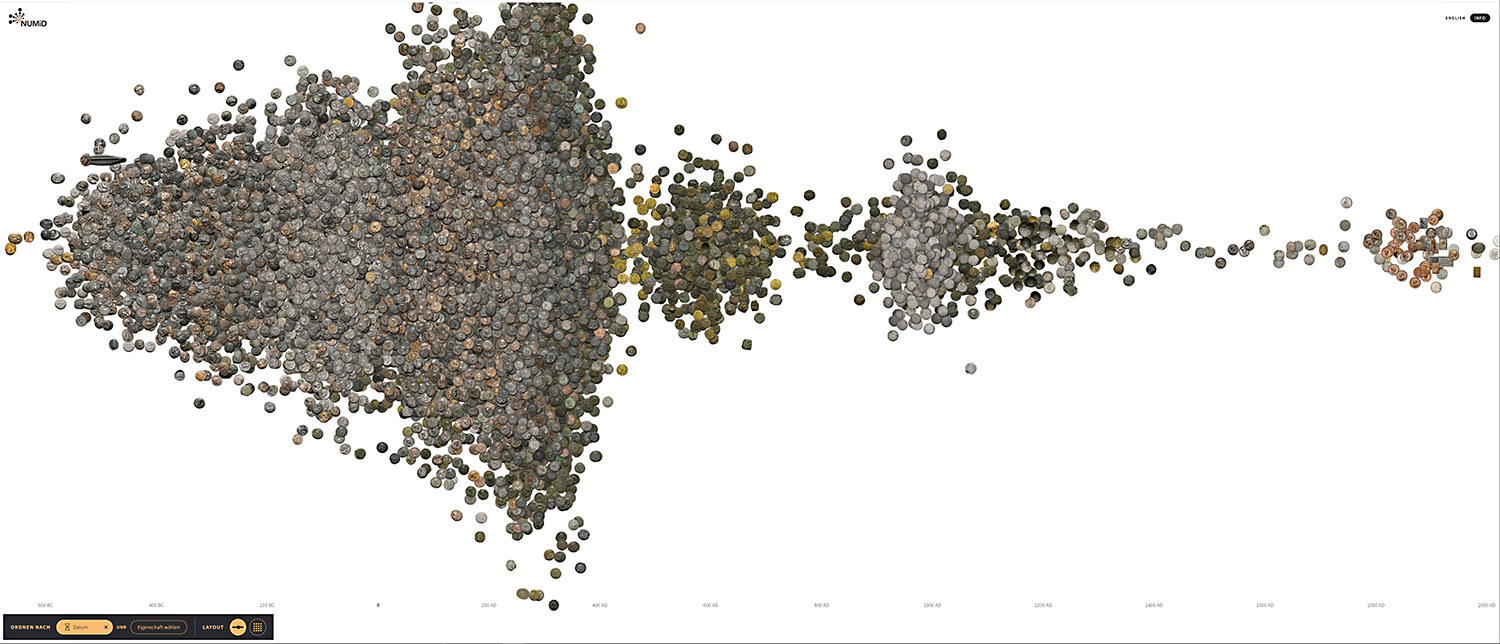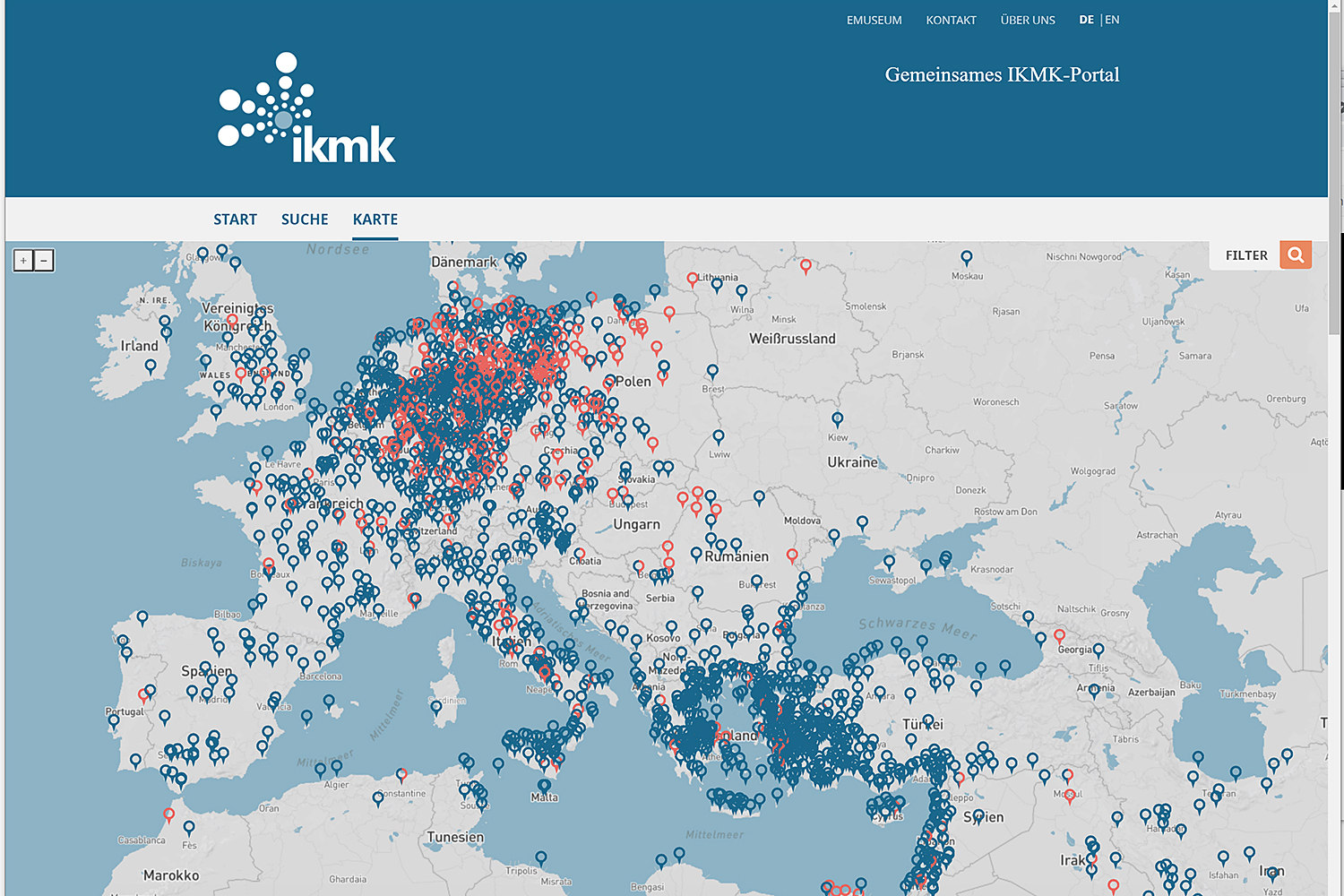Picture of the Month: A special kind of treasure Submitted by Professor Johannes Wienand
If Scrooge McDuck were a historian, he’d have a blast with this pile of coins: a massive mountain of coins, carefully aligned along a timeline that stretches from the beginnings of coinage in the seventh century BC to the present day. The assemblage spans from early electron money, the first coins ever minted, through the Greek silver coinage of the classical and Hellenistic periods, then through Roman aces, sestertii and denarii, on to late antique and Byzantine gold coins, Islamic dirhams and medieval bracteates, and on to modern medals and coins from our own time.

Screenshot of the web portal visualize.numid.online. Digitized copies of around 30,000 coins from university coin collections, sorted by minting date: a fascinating insight into 2,600 years of monetary history. Picture credits: Johannes Wienand/TU Braunschweig
This special kind of treasure has been compiled by a network of university coin collections. Each individual coin, which is arranged here according to its minting date, is based on a sophisticated digital recording and description of the respective original object. More than 30 German universities are working together to digitize their coin collections in a scientifically based way for research and teaching. The digitized individual objects then flow together on the portal visualize.numid.online, among others.
The screenshot of the chronologically sorted pile of coins comes from there. Here, anyone can rearrange the approximately 30,000 coins at random – for example, by mint, material, weight, diameter – and thus gain ever new fascinating insights into the valuable holdings of the university coin collections in Germany. Each individual coin can be selected individually. A mouse click takes the user to the digital coin cabinet of the respective collection of origin, where all relevant detailed information on the selected object is stored. For example, you can also access a coin of the Roman Emperor Constantine, which is in the collection of TU Braunschweig.

Screenshot of the ikmk.net website. Geographical overview of the minting sites (blue) and finding sites (red) of about 100,000 historical coins from collections of the IKMK network. Picture credits: Johannes Wienand/TU Braunschweig
The Network of University Coin Collections in Germany
The digitization network providing the data is called “Network of University Coin Collections in Germany” NUMiD. Such an association is so far unique in the world. The research and digitization network was founded by Professor Johannes Wienand, who is responsible for the history of Greek and Roman antiquity at TU Braunschweig and who also heads the coin collection at the Herzog Anton Ulrich Museum. The database family, which the university collections have joined, now spans universities and museums in four European countries. About 100,000 objects are brought together in this way. They are jointly searchable via the portal ikmk.net – about one third of the data was compiled within the NUMiD network.
“The willingness of such a large number of collaborative partners to embark on this joint scientific adventure is the crucial prerequisite for the success of the project, and the support of the Numismatic Collection of the National Museums in Berlin as a non-university collaborative partner provides the necessary institutional stability,” says Johannes Wienand.
Digitizing for research
The historically and materially valuable original objects are photographed, identified and described in the university institutes to which the collections belong by staff or, in the context of courses, also by students; for the creation and publication of the digitized material, the collections use a common database system and a common pool of standardized concepts (norm data). Interfaces enable the export of data to international research portals. Statistical evaluations and Big Data analyses are then possible there. The possibility of data visualization via the visualize portal is basically just a byproduct of digitization at the network – albeit a very appealing one. “The main goal is to make the collections accessible for research,” says Professor Wienand. The basis (in addition to high-quality front and back photos) is a scientifically valid documentation of the objects – their material properties, their geographical, chronological and political location, their image and text programs, and their provenances.

Sorting of the digitized material by participating collections, seen here (clockwise starting top left): Freiburg, Tübingen (Classical Archaeology Collection), Braunschweig, Bochum, Münster, Kiel, Mainz, and again Tübingen (Collection of the Research Center for Islamic Numismatics Tübingen). Picture credits: Johannes Wienand/TU Braunschweig
Coins as testimonies of history
“The digitization of historical coins is thus not only a valuable contribution to the documentation and protection of cultural heritage, but also an important act of basic historical research,” emphasizes Professor Wienand. “Because coins were minted since the sixth century B.C., initially in the eastern Mediterranean region and soon far beyond, by a large number of cities, city federations, principalities and kingdoms or even empires, serially provided with sometimes rapidly changing image and text programs, and distributed among the population in large quantities.” Due to their special material properties, coins have been able to survive over the centuries and millennia as original testimonies; they can usually be dated well and assigned to specific mints; thus, the objects provide insights into economic-historical contexts, but also into levels of political communication and representation of power that lie far below the radar of literary tradition.
Johannes Wienand also sees this as an opportunity for university teaching: “Particularly in the case of epochs with a patchy literary tradition, coins offer a variety of thematic starting points for academic teaching. A big plus of digitization is that students, even at smaller, resource-poor institutions, can participate directly in basic research and, for example, create their own digitized copies of coins or even design online exhibitions in the portal of the NUMiD network.”
